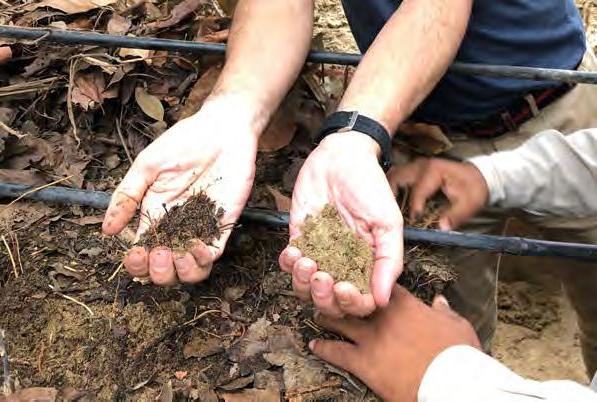
4 minute read
OUR SOIL, OUR SOUL
Healthy soils are our most important resource. The soul of Ingleby. As long-term land owners, we constantly work to improve the quality of our soils.
Crop production involves soil disturbance to some extent, that might result in soil erosion. Therefore, we use practical farming approaches that support crop production while effectively protecting the soils.
We improve our soils by leaving sufficient crop residues on the ground, using cover crops and minimum tillage, maintaining healthy crop rotations, and adding compost and livestock manures where available and cost effective.
We also contour plough, add nutrients to avoid depletion, use non-chemical weed controls, satellite-guided input applications and tractor-wheel path tracking.
We define and monitor our soil’s qualities in relation to its ability to support crop growth. We assume that by improving soil properties that contribute to improved crop production, we also contribute to the other environmental services that soils provide.
SOIL ORGANIC MATTER
Soil organic matter is the non-mineral part of soil consisting of microbial cells, plant residues, debris and humus. It is concentrated in topsoil and decreases with depth. Our challenge is to build up soil organic matter at levels that support good soil quality in terms of tilth, porosity, drainage, nutrient supply, and biological activity. This will help grow our topsoil layers and support our crop production.
Soils with a high organic matter content can also store large amounts of water. This is crucial for our crop production and improves our farms’ resilience to floods and droughts.
BUILDING HEALTHY SOILS
We have a constant goal to build healthy soils on our farms, and part of this is to grow the topsoil layer by 2 mm per year. Crops respond positively to soil with good structure, and high water holding capacity. The better and deeper the topsoil, the larger an area for the plant roots to find water and nutrients, and the stronger the crop.
To measure how our soils are developing, we take reference soil samples from representative areas of the farms every five years. The locations of these sampling sites remain constant. We analyse the soil samples for all key soil properties that determine soil quality. We combine these results with those from our annual crop nutrient balances and leaf nutrient analyses. This allows us to understand how our farming practices affect soil quality and how to better manage our soils.
EARTHWORMS
In 2018/19, we began to count the number of earthworms present in our soils as a quick measure of soil health that we can easily track over time.
GOAL 2 // ZERO HUNGER
Soil is a key resource for farming. About 95% of all food comes from soils. Healthy, fertile soils can increase biodiversity and crop production.
We make annual assessments of our soils' quality. We combine it with other ways to track soil health, such as reference soil sampling, measuring nutrient balances and earthworm counts.
To protect and improve our soils, we aim for minimal soil treatment to reduce potential erosion. We diversify our crops and add cover crops that help build soil organic matter. We add lime to increase soil pH and nutrient availability.
GOAL 13 // CLIMATE
Healthy soils are capable of more than just producing food. They help combat climate change by storing carbon, since plants absorb CO2 as they grow and then push extra carbon into the earth through their roots. They also provide essential biological functions, such as storing and filtering water as well as degrading and detoxifying pollutants.
Typical farming techniques, including tillage and leaving the soil bare between crops, releases carbon. It is estimated that farmed soils around the world have lost 50-70% of the carbon they once contained. However, increasing the world's soil carbon content by just 2% would offset all global greenhouse gas emissions.
We have adapted principles from regenerative agriculture, such as minimum tillage and using cover crops or companion cropping to always keep our soils covered. By protecting our soils and covering our fields with live and dead organic material, we help to remove CO2 from the atmosphere.
Earthworm population density is directly affected by soil properties and management practices. Therefore, year-to-year comparisons of earthworm numbers will be another indicator of how our environmental and management decisions are effecting our soil health.
SOIL SENSORS
We use soil sensors to track real time moisture content. This allows us to respond instantly to changes in soil moisture and vary irrigation according to the needs of the crop – minimising water use and providing optimised growing conditions.
SOIL MAPS
On some of our farms, we use electromagnetic pulse technology and radiometry to create detailed soil maps. Based on these maps we use variable rate technology to optimise sowing density, crop nutrition, crop protection, soil amelioration and irrigation.
AVOIDING SOIL EROSION
To avoid erosion, we never cultivate fields straight up and down the slopes. Instead, we cultivate along the contours. We keep erosion prone slopes under permanent cover. These areas are left for natural regeneration, or planted in native species.
We have implemented contour terraces to manage water runoff and reduce soil erosion.
We plant waterways in permanent grass in low parts of fields where water runs during wet conditions. These grass waterways collect and channel runoff water to a specific outlet. They also reduce water velocity and absorb destructive energy that causes soil erosion and gully formations.










